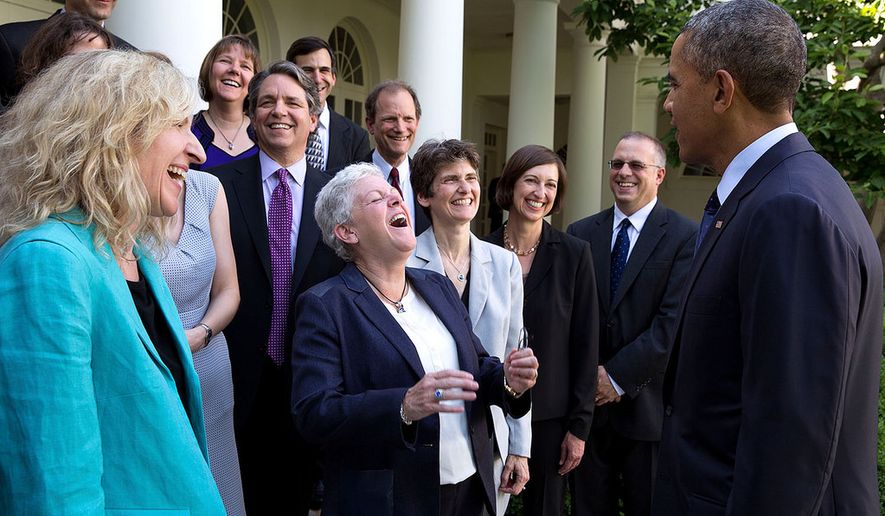The EPA and environmental groups are exceptionally close for a government agency and lobby groups, with a revolving door and pressure from the groups often shaping EPA’s policies, according to a new report from a conservative watchdog group based on emails obtained in a yearslong battle with the agency.
The report, which details what the Energy & Environment Legal Institute terms “collusion” between the Environmental Protection Agency and eco-friendly groups, is also a study in the way E&E used open records laws to force transparency on a secretive agency.
Chris Horner, the report’s author, said the emails show EPA officials aren’t acting as impartial regulators but as committed environmentalists whose minds are already made up on a number of the big issues that come before the agency. Mr. Horner said it was the equivalent of the EPA collaborating with oil companies.
“These emails reveal the realities of how the Obama EPA operates, and candid admissions among themselves and pressure group allies about their shared agenda and its impacts,” Mr. Horner said. “The emails’ content also explains why the administration so furiously opposes efforts to obtain the oft-promised transparency: These realities wouldn’t possibly sit well with the broader public.”
The EPA didn’t respond to a request for comment, and neither did the Sierra Club, which takes the lion’s share of criticism from the report.
Mr. Horner’s report lists numerous times that EPA officials didn’t recuse themselves despite handling decisions where their former colleagues at environmental groups were lobbying them for a specific outcome.
SEE ALSO: EPA hears testimony on proposed carbon emissions rules
He also details collaboration between the EPA and the Sierra Club to try to shape press coverage, the EPA letting Sierra Club officials submit comments for the public record even before the official comment periods had begun, and EPA officials soliciting legal opinions from the Sierra Club on how the agency might go around Congress and take action on its own.
The relationships went both ways: Sometimes Sierra Club officials would offer up their work in personal messages to senior EPA officials, and other times those senior officials would specifically ask for Sierra Club input ahead of big decisions.
In one example in the report, Duke Energy was about to get North Carolina’s approval for a permit for a power plant when Sierra Club officials raised it with the EPA. A top EPA official then sent a letter to North Carolina raising those exact same concerns on behalf of the Obama administration, the report says.
Mr. Horner, in the report, said the emails detailing the exchange were released to him twice — once with the collusion with the Sierra Club redacted, and once with that included but with the EPA’s plans to object to North Carolina redacted.
“These emails inarguably present impermissible conflicts of interest and a clear pattern of improper collusion, improper influence and a lack of real opportunity for others to have input into, or equal opportunity to comment on, EPA’s rule-making processes,” the report says. “The minds of senior Obama EPA appointees, implementing a costly and admittedly (among themselves, in email) ideological agenda, were closed.”
The report, which runs to more than 300 pages and includes copies of the key emails showing collaboration, is the result of several years of open records requests and repeated court challenges.
Mr. Horner, who in 2012 revealed former EPA Administrator Lisa P. Jackson’s use of the secret Richard Windsor email address, said his open records requests were pulled out of the normal process at EPA and given to the agency’s top Freedom of Information Act staffer, who sat on the request for months, in violation of the law.
In an earlier report, E&E had accused the EPA of bias in handling open records requests. When someone submits a request, he can also ask for a fee waiver, arguing the information is in the public interest. The EPA generally approved environmental groups’ fee waivers while denying requests from E&E and other conservative groups.
The EPA’s inspector general, however, disputed that. In a July report, the inspector general said it had reviewed a sample of hundreds of fee waiver requests and found almost all of them were properly decided.
E&E said its own calculations showed 58 percent of environmental groups’ waivers were approved, but E&E and another conservative group, the Competitive Enterprise Institute, only had 25 percent of their requests granted.
• Stephen Dinan can be reached at sdinan@washingtontimes.com.




Please read our comment policy before commenting.